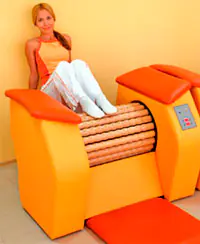What will help you relieve tension, relax well and recover well after a hard bodybuilding or fitness workout? Well, of course a massage! Moreover, nowadays it is not even necessary to look for an experienced massage therapist. Its work can be performed no less effectively by numerous massage devices; one of such devices will be discussed in this article...
There are currently a countless number of massage devices in an athlete’s arsenal. These are, first of all, standard devices, such as a ribbed massage track or drum, domestic massagers “Bodrost”, VMP-1, “Sport”, “Tonus”, EMA-2M and other well-known domestic and foreign analogues, which are not enough to list no time or effort...
Compared to hand-held devices, massagers in health centers have their own characteristics. First of all, along with those listed above, devices are used that have large overall dimensions, heavy weight, significant cost, and are difficult to operate. Let's give a few examples...
In our review we will study in detail such a device as a massage drum. Its analogue, the ribbed massage track, is actually designed in a similar way, except that it has not a convex, but a flat working surface for contact with the target area of the body being massaged...
The massage drum is driven by an electric motor with a gearbox. The gearbox is not a necessary component and is used only if there is no low-speed engine. A pulley is mounted on the output shaft of the gearbox, connected by a V-belt drive to the side wall of the drum. A groove is machined on the wall of such dimensions that the upper surface of the belt is flush with the generatrix of the drum wall. The drum rotation speed is constant and equal to 50 rpm.
See picture No. 1. Massage drum:a - general view; b — massaging roller design; c — profiles of massaging rollers
Between the two side surfaces of the drum there are massage rollers - the main part of the massager, its working body. The number of massage rollers is 16. They are put on metal pins that tighten the side surfaces of the drum.
Let’s take a special look at the design of massage rollers. Their ribbed lateral surface is formed by the rotation of a sinusoid.
The massage roller of the first design is formed by a sinusoid starting from the zero mark (Fig. 1, c). The surface of the roller of the second design is the same sinusoid, but shifted relative to the first by a quarter of a period. For the roller of the third design, the sinusoid is shifted by another quarter of the period, i.e., half a period relative to the first. And finally, the roller of the fourth design is shifted by another quarter of the period, i.e., three-quarters relative to the first roller.
For a ribbed massage drum, as well as for a track, massage rollers are usually used in the amount of four of each of the four above designs. They are arranged like this: the roller of the first design, then the second, third, fourth and again the first.
Use the drum as follows: turn it on and press the massaged area of the body against the rotating drum. In this case, you can hold with your hands the side walls of the device, in which special slots are made for this. Thanks to the design of the rollers, the convexities of which are shifted relative to each other, the massaged tissues falling between the convexities are rhythmically compressed and unclenched.
The force of pressing the massaged area against the drum depends on the engine power level, but, on the other hand, in any case, it is limited by a painful sensation that should not occur on the massaged area.
Using a drum of this design, you can massage your limbs, chest and abdomen. To massage the back, a structure like a hockey goal is installed above the drum, holding onto which the person being massaged leans back and presses his back against the drum. The treadmill, due to its design features, can only be used for massaging relatively flat areas of the body, such as the chest, back, and abdomen. Massaging your limbs on it is not very convenient...
Post Views: 119


